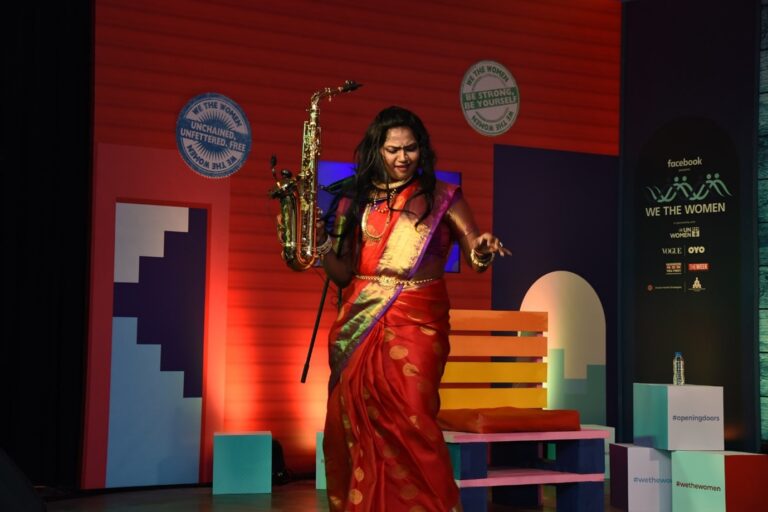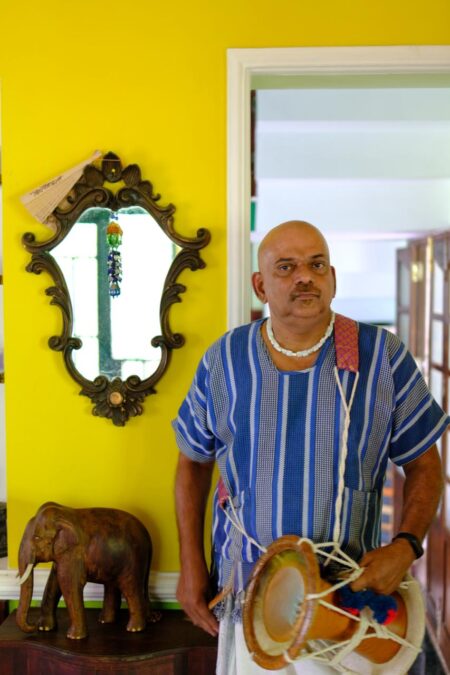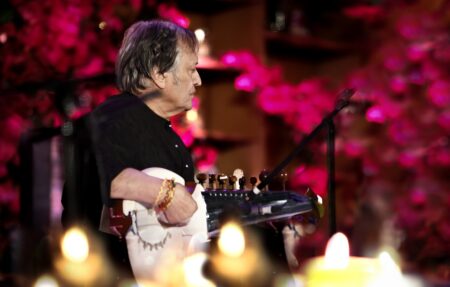From facing ridicule to breaking records, M S Subbalaxmi’s inspiring journey as a female saxophonist.
When M S Subbalaxmi started on her journey to learn and master the saxophone, a Western single-reed woodwind instrument, the notion of a female musician excelling in this domain seemed impossible. But Subbalaxmi, inspired by her guru Kadri Gopalnath, silenced the stereotypes with every note. Today, “Saxophone Subbalakshmi,” as she’s known, commands a global fanbase and shatters boundaries in a traditionally rigid industry.
In defiance of societal expectations that imposed sexist ideals on female musicians, she disregarded criticisms targeting her gender, boldly embracing an instrument traditionally associated with male musicians. She paid no attention to comments regarding the physical challenges posed by the 7-kilogram instrument during extended stage performances. Nor did she entertain ‘benevolent’ suggestions advising her to focus on conventionally gendered activities like cooking, rejecting the prevailing opinion that such pursuits would be more “useful for a girl of her age.”
Subbalaxmi’s inspiring journey
M S Subbalaxmi’s musical journey stands as an inspiring saga for all female musicians. Despite the advantage of being born into a musical legacy and surrounded by a family of musicians, she remained susceptible to the biases of a sexist society that attempted to dissuade her from pursuing the learning and performance of the saxophone.

Finding solidarity in the shared experience of gender-based marginalisation can be a source of relief for many female musicians. It is imperative to acknowledge that the true measure of their talent should always be the quality of their music, not their gender identity. The societal perception of incompetence often stems from gender identity when it comes to female musicians, as argued by critic Shristi Khare.
In the field of music, women are frequently sidelined or supervised by men. M S Subbalaxmi’s narrative reinforces this argument, emphasizing that her musical lineage and the similarity of her name to the music maestro M S Subbulakshmi did not shield her from judgment based on her gender identity.
Musical legacy
M S Subbalaxmi came from a family deeply involved in classical music, especially focusing on percussion. Her grandfather, a mridangam player from Mangalore, served as an Asthana Vidwan in the Royal Court of Mysore. Meanwhile, her father, M R Sainath, gained recognition as a child prodigy and later worked as a staff artist for All India Radio.
She started learning Carnatic music at the age of five. During her early years, Subbalaxmi’s father often played the Mridangam with renowned musicians, including Kadri Gopalnath, during their performances. Watching these collaborations, especially her father’s concerts alongside Kadri Gopalnath, sparked her interest in the saxophone. This exposure during live performances played a vital role in developing her fascination with the instrument, paving the way for her later exploration and mastery of the saxophone.
At the age of 13, she became Kadri Gopalnath’s only female disciple. However, she faced unsupportive fellow learners, with only her teacher’s son backing her. Despite ridicule and challenges, her supportive family and Kadri Gopalnath’s family encouraged her to pursue her passion, overcoming obstacles in learning the instrument and battling negativity.
Her difficulties went beyond her ability to physically carry the instrument. She found it more challenging to change the societal mindset that was unable to acknowledge a woman performing on saxophone. It was difficult to get stages and even when she was given slots during concerts, they were for mere 10 minutes! Despite these constraints, the audience thoroughly enjoyed her brief performances, prompting concert managers to yield to audience demand and allocate additional time slots for her. Still, she was not given any prime time shows and she stated that there was no proper payment for her performances.
The gender- based norms asserted that the women performers are incompetent and cannot be economically equal to their male counterparts. There were comments on her performance as well as her physical movement on the stage which she dismissed with contempt and ventured upon bringing in hybridity to her music. The undeniable power of her music and the mastery she had acquired over the saxophone got appreciation from her audience, breaking down barriers and challenging preconceived notions about gender roles in music.

She recollects how the audience were asking for refunds for the tickets they bought for her performance once they came to know that she was pregnant. She performed on stage just a day before her delivery, loudly proclaiming her space as a musician who is professional enough to balance her career and personal life. This effort represented a determined resolve to dispel rumours surrounding the alleged incompetence of India’s female saxophonist, debunking misconceptions related to her gender identity and the physical demands associated with it. During those days she and her sister Lavanya, who later came to be known as the Saxophonist Sisters, were the only women who played saxophone in India.
Harmonizing east and west
While managing her professional responsibilities and personal life, M S Subbalaxmi expresses gratitude for the support received from her parents, husband, and other family members. Her narrative of overcoming challenges serves as a source of solidarity for many women who later pursue the saxophone. Her resilience and perseverance act as a unifying force, inspiring those facing similar challenges and fostering a supportive community among women in the saxophone world. This shared understanding emphasizes the importance of collective strength and determination.
During her stage performances, Subbalaxmi’s persona intriguingly balances elements from both the East and the West. Purposefully adorned in rich silk sarees and heavy jewellery for all her concerts, she aims to familiarise the audience with the unifying power of music, bridging the gaps between Eastern and Western influences.
Subbalaxmi engages with a diverse range of music genres, including Pop, Folk, Western, and Carnatic, experimenting with hybrid combinations. Her concerts showcase a judicious mix of these musical forms, enchanting the audience with her diverse repertoire. Even Western audiences enthusiastically seek out her distinctive fusion style. She maintains this balance by staying informed about the latest trends while firmly grounding herself in tradition.
She has been featured in the Limca Book of Records and has received numerous awards and honours. Her story exemplifies the importance of speaking out against sexist ideologies that attempt to silence women by evaluating competency through the lens of gender rather than talent and mastery. She serves as an assurance to upcoming female musicians that their paths may not always be smooth, but there is always hope if they persist and fight for their passion.




